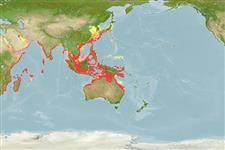Preferred temperature (Ref.
115969): 24.3 - 29.1, mean 28.1 (based on 1436 cells).
Fylogenetische diversiteitsindex (Ref.
82804): PD
50 = 1.0000 [Uniqueness, from 0.5 = low to 2.0 = high].
Bayesian length-weight: a=0.02570 (0.02118 - 0.03119), b=2.89 (2.83 - 2.95), in cm Total Length, based on LWR estimates for this species (Ref.
93245).
Trofisch niveau (Ref.
69278): 2.9 ±0.35 se; based on food items.
Weerstandsvermogen (Ref.
120179): Gemiddeld, minimale populatieverdubbelingstijd 1,4-4,4 jaar (K=0.6; Fec=1,692).
Prior r = 0.57, 95% CL = 0.37 - 0.85, Based on 15 data-limited stock assessments.
Fishing Vulnerability (Ref.
59153): Moderate vulnerability (35 of 100).
Climate Vulnerability (Ref.
125649): Very high vulnerability (86 of 100).
